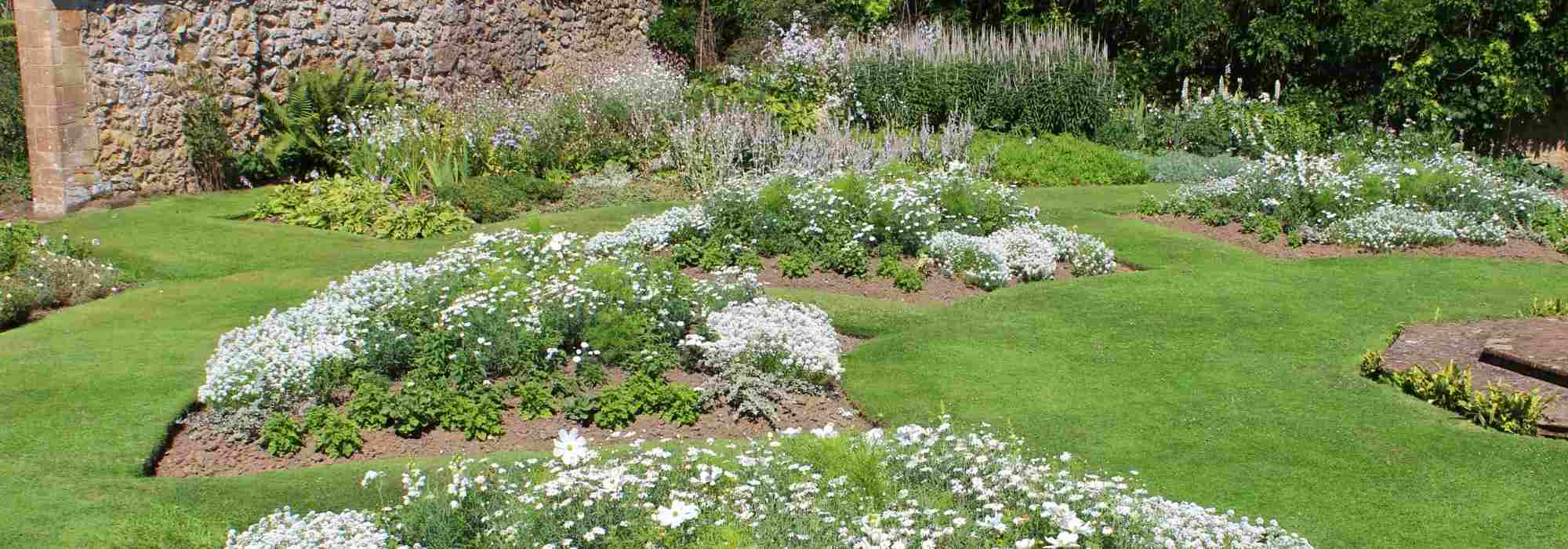
9 landscape designer tips to create a white garden
For an elegant and refined ambience
Summary
Neutral tone, white can declinate into the sole colour in a garden, or in a sub-area of the garden. Becoming trendy, inspired by beautiful English gardens, white monochrome garden is synonymous with elegance and purity, it gives a feeling of calm and lightness. Often romantic in English gardens, it suits contemporary and even Mediterranean styles very well.
But a monochrome garden, white moreover, requires compositions and layouts that cannot be improvised. Because choosing plants with white flowering is not enough to create a beautiful space. Often attractive in high summer, this type of unique garden remains essentially seasonal. Knowing how to use different whites, create volumes, contrasts of foliage and texture for a successful visual effect, designing with seasons for a lasting white garden is essential.
Follow our tips to design a white garden: discover extraordinary white palette offered by plant world!
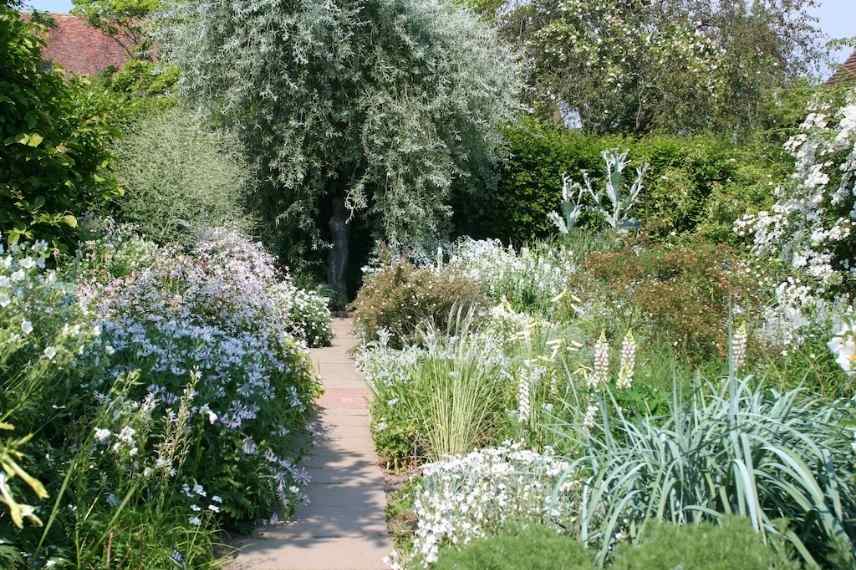
Famous Sissinghurst white garden in England (Photo : M. Manners)
→ Also read our advice sheet Pairing white flowers
Imagine your ideal garden
From small garden to terrace and large garden, white features in many spatial configurations. A colour that brings plenty of light, white is indeed at ease in confined volumes that it visually enlarges, and readily asserts itself in larger-scale gardens where it radiates. It can also simply occupy a garden-within-a-garden.
Naturalistic, contemporary, country-style… different plants will be chosen! English or natural gardens will rely on light plants that look as if they have always been there, in mixed borders carefully planned to appear as natural as possible, combining free, flowing habits and the introduction of bulb plants.
In more structured contemporary or Japanese-inspired gardens, opt for more woody, graphic plants, with habits suited to pruning, upright or sculptural perennial plants, while composing mainly with white-flowering perennial plants, essential elements of the white garden.
Romantic garden readily dresses itself with roses, clematis, wisterias, lilies, sedums, thalictrums, Japanese anemone ‘Honorine Jobert’… Natural or wild garden is superb when composed of Lysimachia, achilleas, sweet peas, love-in-a-mist, chamomile, crocuses, daffodils, daisies, cosmos, foxgloves, lilacs… Contemporary garden displays more slender, dynamic and graphic habits: yuccas, Eremurus, miscanthus. For an exotic take, favour the large luxuriant foliage of arums, rodgersias, ferns and acanthus… while a Mediterranean white garden will favour cacti, blending Cistus, yuccas and sedums.
You can even go as far as a Japanese-style garden with carefully chosen varieties of cherry trees, magnolias, azaleas and rhododendrons, pieris, Viburnum plicatum !
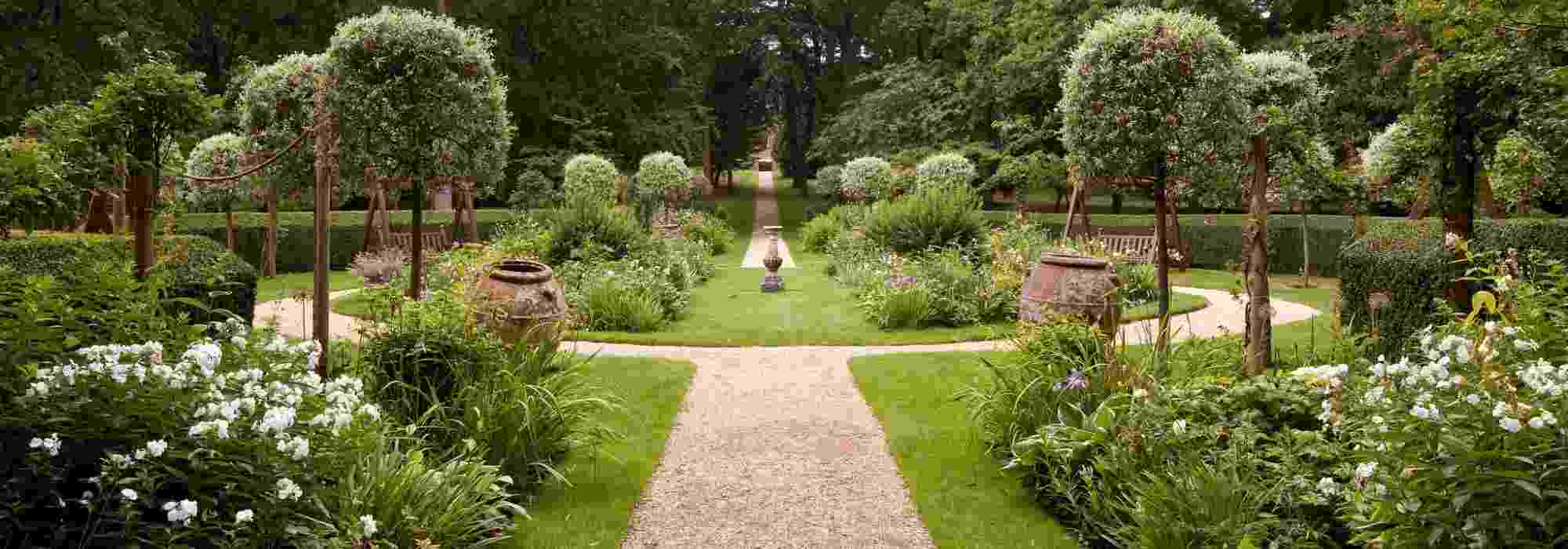
White garden at Buscot Park in England (Photo: A. Harris)
You may also read
7 ideas for white garden bedsWhite and Whites
Is white reductive? Both simple and sophisticated, it evokes purity and softness. Far from being reductive, its palette is on the contrary rich and subtle, ranging from pure whites to creamy whites, pinkish whites, pale yellow-tinged, green-tinged or slightly greyed whites. That does not take into account white flowers that are spotted or striate, and silver and variegated foliage.
It is with this very diverse palette that you will need to compose to avoid the monotonous, flat effect that white can produce. Combine immaculate whites with nuanced whites through stamens often tinted yellow, flowers edged with mauve or yellow, even slightly freckled. For Hydrangeas, choose those that turn green in autumn for better harmony.
Pure whites: Galanthus, Platycodon, many heathers, lilies, Davidia involucrata, Magnolia stellata, Cornus kousa…
Creamy whites: Hydrangeas, Magnolias, Tulips, Astilbes, many roses…
Pinkish whites: Acanthus ‘Whitewater’, Erigeron karvinskianus, Gauras, some Hellebores, many roses, Kolkwitzia…
Greenish whites: Galanthus nivalis ‘Flore Peno’, Hydrangea paniculata ‘Limelight’, many Hellebores
Yellowish whites: Iris, Hellebores, Asters, Potentilla fruticosa ‘Limelight’
Speckled whites: Digitalis purpurea, Clematis cirrhosa ‘Balearica’, rockroses…
Contrasting whites (often with a coloured centre) to insert as touches, around foliage that sets them apart from other white flowers: Poppies, Romneya coulteri, rockroses, cosmos, chamomiles, daisies, daffodils…
Also read our article on designing a silver-white garden!
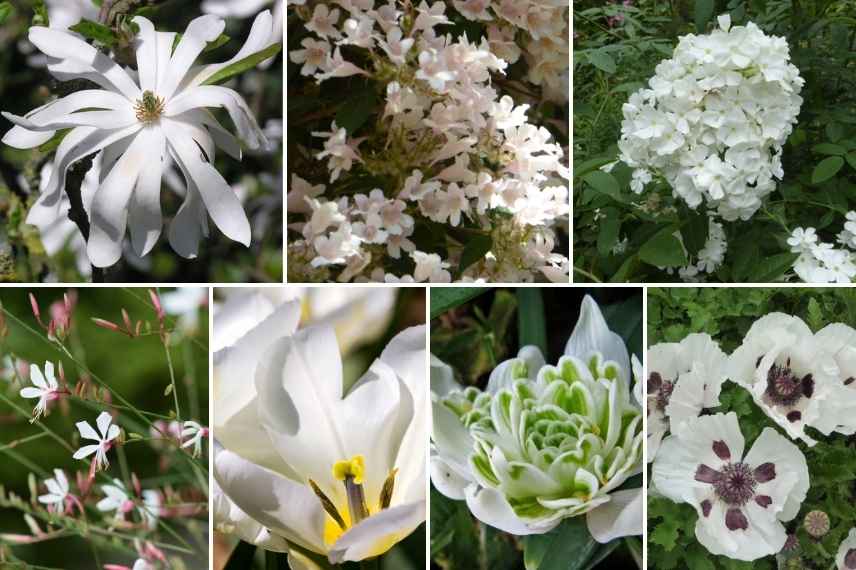
Myriad shades of white: Magnolia stellata, Kolkwitizia, phlox, gaura, tulip, snowdrop ‘Flore Pleno’, poppy
Discover other White garden inspiration
View All →Available in 0 sizes
Available in 1 sizes
Available in 1 sizes
Available in 1 sizes
Available in 1 sizes
Available in 1 sizes
Available in 1 sizes
Available in 2 sizes
Available in 1 sizes
Available in 1 sizes
Combine foliage
To accompany immaculate flowering, make lavish use of foliage! This creates a unique atmosphere where greenery enhances flowering. Silvery, variegated-with-white and bluish tones wonderfully reveal whiteness of inflorescences. Take care to avoid foliage emerging or finishing in red tones that would clash, and to select only flowers that must be white!
Also rely on very diverse leaf shapes to create interesting textures and volumes : slender like the Helleborus feotidus, broad like hostas, fine like shrubby willows and all grasses, deeply divided like acanthus, light like ferns, etc…
In a sunny position, darker foliage will add more depth.
– silvery and greyish foliage : Artemisia, Stachys officinalis ‘Alba’, Convolvulus cneorum, Helianthemum ‘The Bride’, Salix rosmarinifolia, Phillyrea angustifolia…
– variegated foliage, marginate with white subtly make inflorescences stand out : many spindle trees, hostas and Carex
– marbled foliage (Brunnera macrophylla ‘Mr Morse’, Pittosporum ‘Irene Patterson’, Lamium maculatum ‘White Nancy’, Heuchera ‘Sugar Plum’)…
– foliage speckled with white such as Pulmonaria ‘Sissingurst White’, Euonymous japonicus ‘Pierrolino’, Fatsia ‘Spider Web’, Salix integra ‘Hakuro Nishiki’, etc.
– glaucous foliage : Hosta ‘Halcyon’, Euphorbe characias ‘Wulfenii’, Euphorbia characias ‘Glacier’, Leymus arenarius, Dianthus plumarius ‘Heytor White’, etc.
– green foliage : whole range of spindle trees (glossy foliage), Euphorbias (velvety), Heuchera ‘Little Cutie Blondie in Lime’, Santolina rosmarinifolia virens, tangy chartreuse greens of Choisyas…
– in small touches only, purple to black foliage with white inflorescences can slip into white garden : Heuchera ‘Binoche’, ophiopogons, Dahlia ‘Happy Single Princess’, Physocarpus…
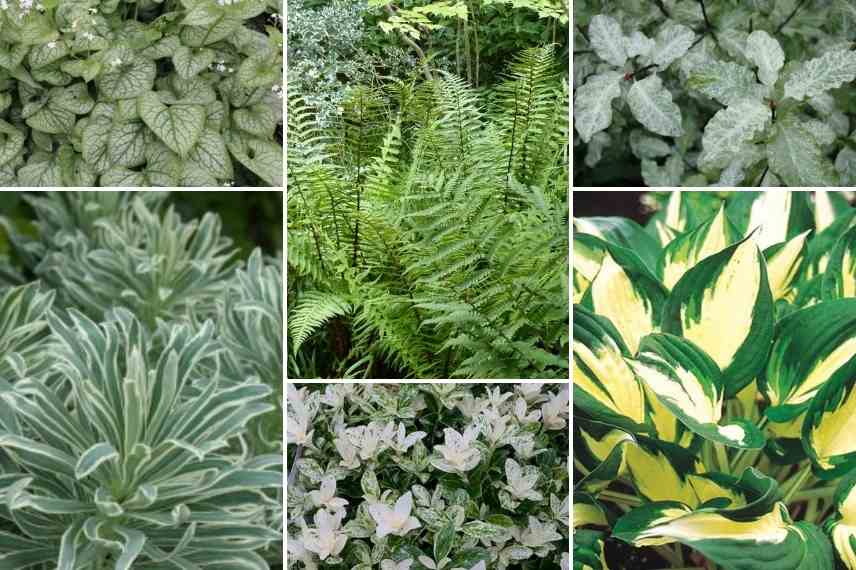
Brunnera, Euphorbia characias ‘Glacier’, fern Dryopteris affinis, Spindle ‘Pierrolino’, Pittosporum ‘Irene Patterson’, Hosta ‘Fire and Ice
You may also read
Best varieties of bushes with white flowersAdd volume and lightness
Prefer airy, natural perennials for backdrop: goat’s beard (Aruncus), Lychnis, Gauras, Gypsophila, Japanese anemones, list goes on… Botanical and English roses are essentials in country- or English-style white gardens, bringing endless grace and great lightness. Many perennials or bushes have a white version (often named ‘Alba’), somewhat less known but of real interest for composing a white garden: Skimmia japonica ‘Fragrant Cloud’, Buddleia davidii ‘White Profusion’, Japanese quinces, white broom (Cytisus x praecox ‘Albus’). Ceanothus, lavender also declinate in white shades, as do lupin and camassia.
Mix inflorescence shapes: spikes (Eremurus, lupins, agastaches, Veronicastrums, Lysimachias, Sanguisorba…), balls (Alliums, Echinops, agapanthuses, hydrangeas…), flat inflorescences (achilleas, sedums, erigerons…) with large petals of irises, arums and dahlias, with aments of pennisetums, etc…
To well-chosen perennials that will provide continuous flowering from May to September, add a few bushes and small trees: they bring necessary height and volume to a garden. One or two specimens suffice to guide the eye and add depth: Amelanchier lamarckii ‘Ballerina’, Davidia involucrata, Cornus kousa, Judas tree (Cercis siliquastrum ‘Alba’), Lagerstroemia, Oleander, for example.
Play with volumes by choosing climbers, pruned and structured plants for some, and light ones for others, with varied sizes and textures.
Also rely on some evergreen shrubs and grasses that will continue to enchant space in all seasons and create volume, whether pruned or not: Phillyrea, Olearia and lavender (with grey foliage), box, perfumed Pittosporum tobira, Pittosporum tenuifolium, Pennisetums, Helictotricons sempervirens, Carex, Stipa barbata…
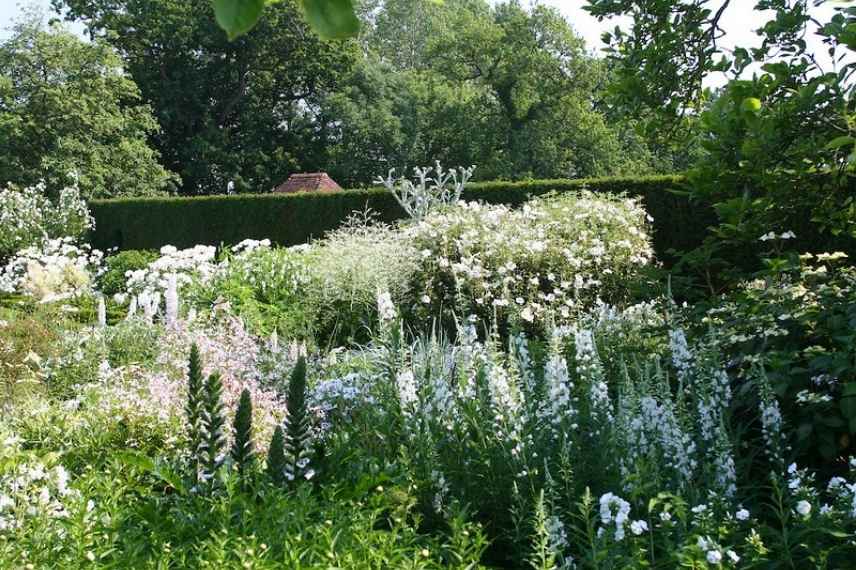
A scene from Sissinghurst’s white garden in England: volumes are created between upright forms and rounded shrubby beds (Photo: M. Manners)
Design according to aspect
White being suited to all aspects, simply make your choice from the very many white flowerings, which you will pair with foliage in various shades of green. Here is a non-exhaustive selection of the most beautiful white flowerings and foliage among perennials, climbers, bushes, groundcovers and grasses :
North or a shaded aspect notably offers a wide range of white flowerings that brighten these areas : many Hydrangeas (including climbing Hydrangea petiolaris), camellias and azaleas, white Acanthus, astilbes, impatiens, bleeding heart, pulmonarias, many groundcovers such as Lamium maculature ‘White Nancy’, and in foliage Helxine, ivy…
South or full sun: palette is almost endless! Roses, white wisteria, agapanthuses, valerian, irises, poppies, mock orange (Seringat), white broom, alliums, Eremurus, Gaura, Spiraeas, Iberis sempervirens, Pennisetums, Gypsophila, Libertias, Eremurus, wide range of Deutzias, Magnolia stellata and many white cultivars, Hebes, Exochorda, sages, santolinas, white rosemary and thyme…
In partial shade: again, you are spoilt for choice… Astilbes, arums, astrances, lilies, Japanese anemones, very many viburnums including the superb Viburnum plicatum or roseum, Choisyas, Trachelospermums, lilacs, honeysuckles, gardenias…
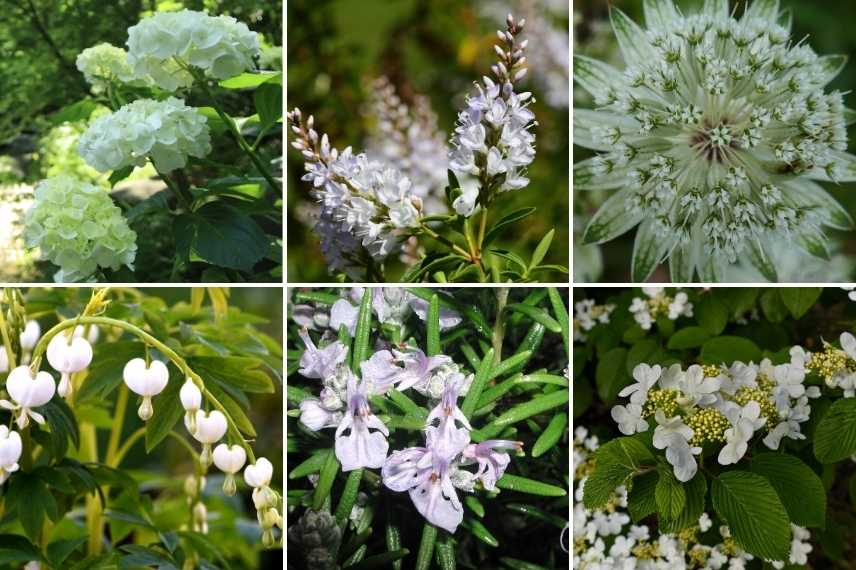
An endless palette for all aspects : Hydrangeas, Bleeding Heart, shrubby Hebe, white rosemary, astrance, Viburnum plicatum
Extend the seasons
White flowering mostly occurs in spring (explosion of white from fruit trees and other bushes, bulbs in abundant bloom) and especially in summer with a myriad of perennials and bushes.
Main difficulty with a white garden is keeping it colourful year-round. Many English “White Gardens” are indeed rather bare during winter months.
To overcome this drawback of the white garden, extend the softness provided by touches of white into autumn and winter: Sedums, Camellias sasanqua, Asters, Cimicifugas, then in winter clematis cirhosa, Lonicera fragantissima, winter heathers, Garrya elliptica, laurustinus… From January onwards, Hellebores, snowdrops, daffodils, white Forsythia (Abeliophyllum distichum), Edgeworthia chrysanta, Cyclamen coum, Cornus alba ‘Sibirica Variegata’, Symphorine… palette is rich, you will have no shortage of choice to adorn spaces with flowering and pure white berries during bleak season.
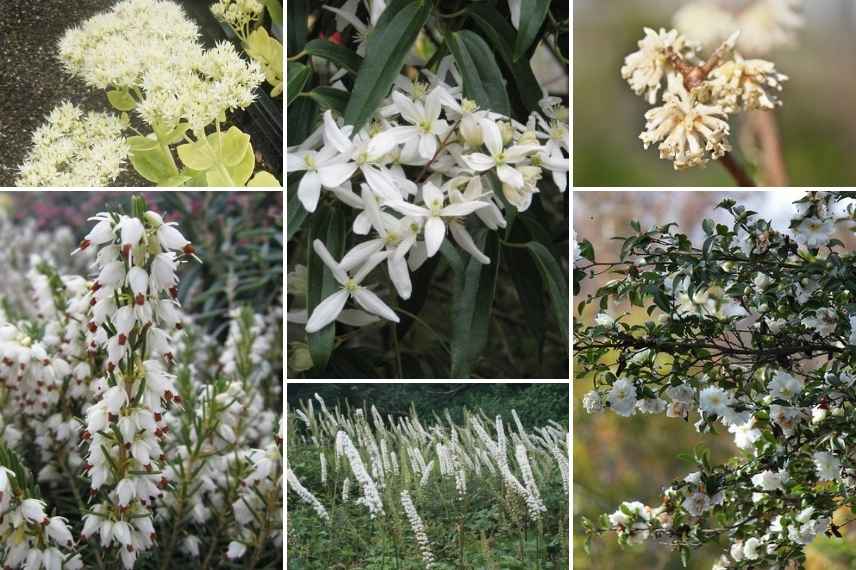
Sedum spectabile ‘Stardust’, Erica darleyensis ‘White Perfection‘, Clematis Armandii, Cimicifugas, Edgeworthia chrysanta, Camelia sasanqua (Photo: H.Koh)
Materials and furniture
Various accessories are welcome in a white garden to provide a focal point and textural effects which delicately accompany pure flowering. It is in no way a question of adding bright colours, but of bringing natural materials onto soil, containers, or furniture that integrate naturally into this airy world.
Gravel and pebbles in pathways accentuate whiteness. Thus a calade (pebbles laid to form a path or small paved area) is perfect, for example, in a Provençal or Mediterranean garden. Slate, brick, stone or tiles provide subtle contrast. Or simply a lawn to define and showcase flowerbeds. Just avoid very light limestone, which sinks into the white.
Wrought iron or Corten steel work well in natural and modern gardens. Pergolas or trellises in wood blend into the setting while bringing an interesting vertical structure. A few antique chairs can punctuate an English garden, as can monochrome pottery that blends into the green.
Stone statuary fits very well in classical, romantic or exotic gardens, and helps dress the monochrome setting. Similarly, benches in wood or metal provide focal points and resting corners conducive to the meditation invited by a white garden.
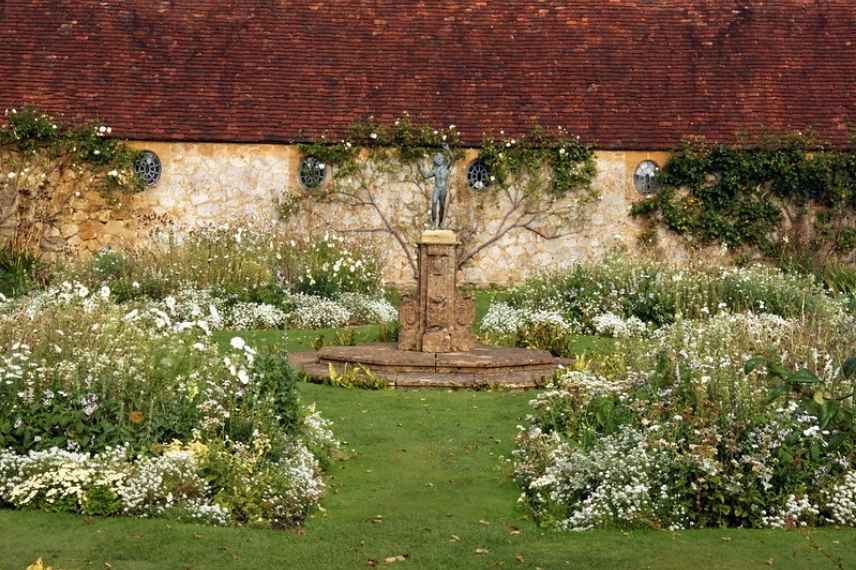
White garden at Barrington Court in England, a beautiful layout centred on a statue
An ideal plan?
Not really… It is rather, as we have just seen, a variation of rhythm playing on planting heights, contrasts of silhouettes and the diversity of forms, textures and foliage colours, that will structure the white garden.
Bear in mind that for a contemporary garden, pure, straight lines are favoured : beds will be square or rectangular, complementing one another in size, and paths will be straight or slanted. For a country, natural or English garden, it is better to organise the different plants into curved shapes, and to create rounded edges that lend a softer, more natural feel to the whole.
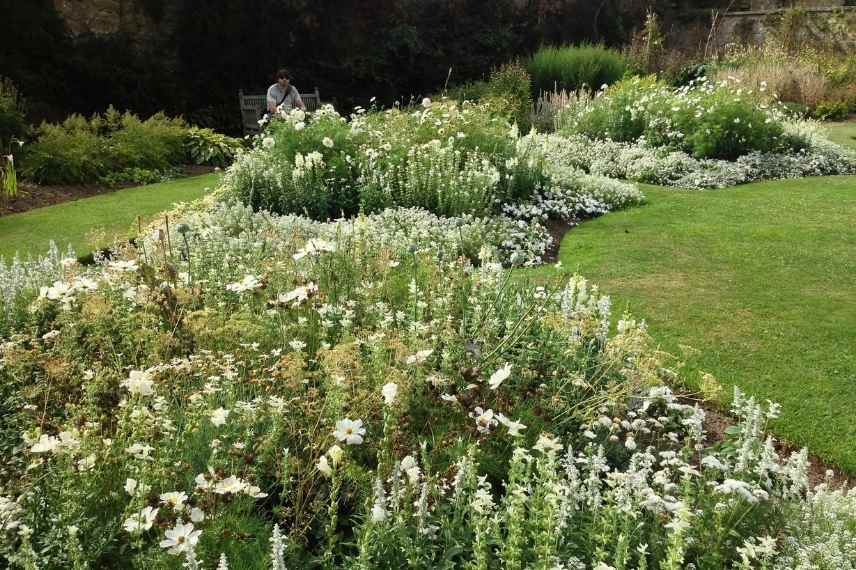
Curved lines for this very beautiful bed in the white garden at Barrington Court in England (Photo: G. Bowman)
Low maintenance
Once your white garden is established and planted, it’s time to pamper it as much as possible so it retains that beautiful immaculate appearance: white blooms often change colour towards the end of flowering, sometimes taking on soft pink hues that further soften the impression of white and add undeniable charm.
Some, however, will turn brown, which is unflattering: deadhead faded inflorescences so as not to mar overall white appearance and to induce, for most perennials, a new flowering, or collect fallen flowers (magnolias or camellias, for example). One exception: you can keep hydrangea heads, which create a unique display on frosty days.
Finally, silver- or grey-leaved foliage with small leaves is known for sun tolerance and low water needs. Many perennials and sun-loving sub-shrubs will require very limited watering… a boon for this pioneering white garden in environmental terms!
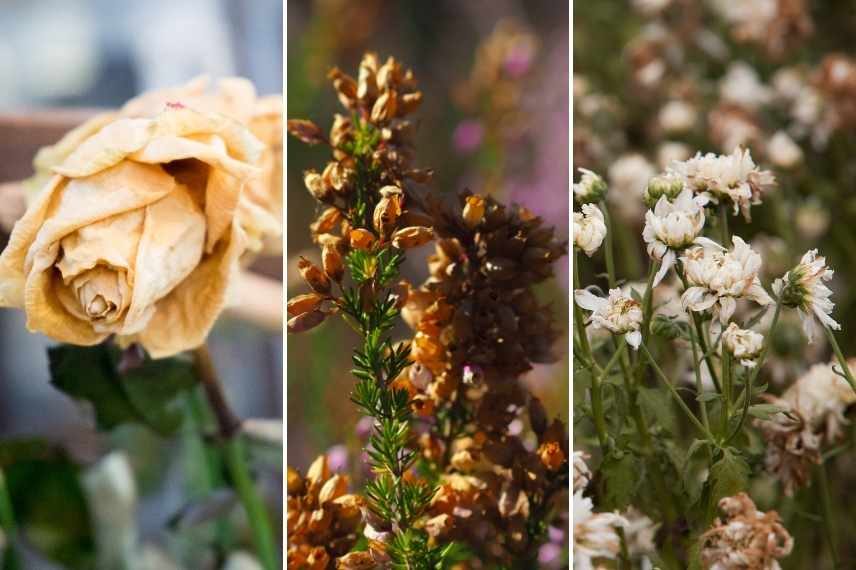
Some flowers require particular care in maintenance when they fade and yellow: roses, heathers, chrysanthemums…
Learn more
Also discover our advice sheets and inspiration:
- 7 ideas for white garden beds
- Perennials with white flowers: best varieties
- Bushes with white flowers: best varieties
- White hydrangeas: 7 best varieties
- Hardy geraniums: 10 best whites
- White garden inspiration
- Silver-white garden: chic elegance!
- Subscribe!
- Contents


































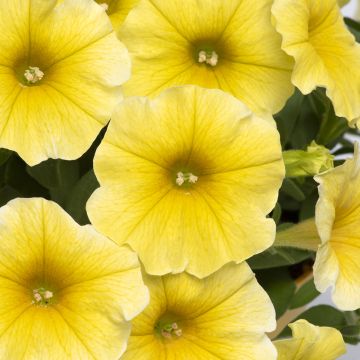
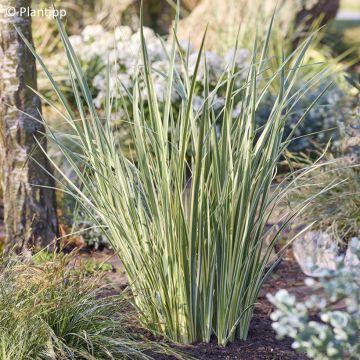
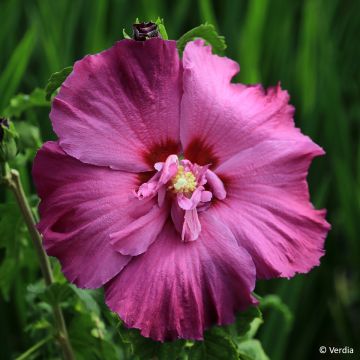
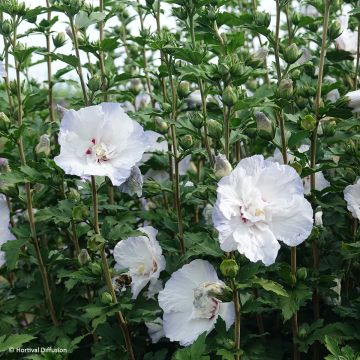


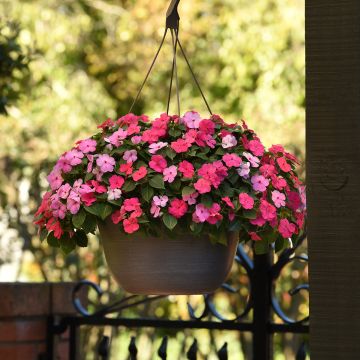
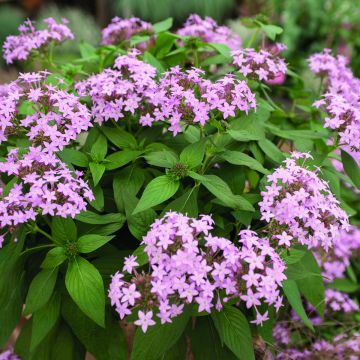
Feedbacks